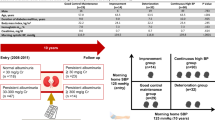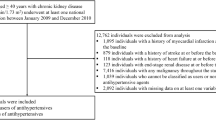Abstract
The purpose of this study was to assess the management of both hypertension and micro/macroalbuminuria in a cohort of type II diabetic patients. In the first 6 months of the year 2000, 5815 diabetic patients were identified through prescriptions for antidiabetic drugs in our sanitary district (191 568 inhabitants). In all, 65% (3810) of these type II diabetic patients were also given prescriptions for antihypertensive drugs. A total of 400 diabetic patients were randomly selected and 171 entered the study (gender: 94/77 M/F; age: 66.6±8 years; diabetes duration: 12±9 years): 100 patients (group DT) were treated with antihypertensive drugs and 71 (group DU) were untreated. Blood pressure, urine albumin-to-creatinine ratio (ACR), and glycated haemoglobin were measured in the two groups. A total of 80% (57/71) of DU patients were hypertensive (BP≥130/85 mmHg). Specifically, 24.4% had diastolic hypertension (BP≥85 mmHg) and 79% systolic hypertension (BP≥130 mmHg). Only 63% (100/157) of the hypertensive patients were treated with antihypertensive drugs (two drugs/patient on average, range 1–5). In addition, only 13% of the DT patients were adequately controlled (BP<130/85 mmHg), while the others had above target blood pressure levels (14%: 130–139/85–89 mmHg; 40%: 140–159/90–95 mmHg, and 33%≥160/95 mmHg). Angiotensin converting enzyme inhibitors (ACE-I) and angiotensin receptor blockers (ARB) were included in the antihypertensive medical regimen in 70% of the DT patients (ACE-I: 62%; ARB: 8%; diuretics: 39%; dihydropyridine calcium antagonists: 38%; α-blockers: 20%, β-blockers: 17%; clonidin: 8%; nondihydropyridine calcium antagonists: 5%). Only 33% of type II diabetic patients underwent a screening for microalbuminuria as assessed on clinical records. The same percentage of micro- and macroalbuminuric patients (13.5%) was observed in the DT group, whereas 25% micro vs 3% macro were found in the DU group. In all, 73% of microalbuminuric patients were not on ACE-I/ARB. Hypertensive type II diabetic patients were often left untreated and only a minority of those treated were optimally controlled. The importance of an elevated systolic pressure is underestimated and the number of antihypertensive drugs prescribed insufficient. Screening and treatment of albuminuria are inadequate.
This is a preview of subscription content, access via your institution
Access options
Subscribe to this journal
Receive 12 digital issues and online access to articles
$119.00 per year
only $9.92 per issue
Buy this article
- Purchase on Springer Link
- Instant access to full article PDF
Prices may be subject to local taxes which are calculated during checkout

Similar content being viewed by others
References
King H, Aubert RE, Herman WH . Global burden of diabetes, 1995–2025: prevalence, numerical estimates, and projections. Diabetes Care 1998; 21: 1414–1431.
Stamler J, Vaccaro O, Neaton JD, Wentworth D . Diabetes, other risk factors, and 12-yr cardiovascular mortality for men screened in the Multiple Risk Factor Intervention Trial. Diabetes Care 1993; 16: 434–444.
UKPDS Group. Tight blood pressure control and risk of macrovascular and microvascular complications in type 2 diabetes (UKPDS 38). BMJ 1998; 317: 703–713.
The sixth report of the Joint National Committee on prevention, detection, evaluation, and treatment of high blood pressure. Arch Intern Med 1997; 157: 2413–2446.
1999 World Health Organization-International Society of Hypertension Guidelines for the Management of Hypertension. Guidelines Subcommittee. J Hypertens 1999; 17: 151–183.
Bakris GL et al. Preserving renal function in adults with hypertension and diabetes: a consensus approach. National Kidney Foundation Hypertension and Diabetes Executive Committees Working Group. Am J Kidney Dis 2000; 36: 646–661.
Cavallo-Perin P et al. Linee Guida della nefropatia diabetica. Giornale Italiano di Nefrologia 2000;17: 47–58.
American Diabetes Association: Standards of medical care for patients with diabetes mellitus (position statement). Diabetes Care 2001; 24 (Suppl 1): S33–S43.
Ritz E, Rychlik I, Locatelli F, Halimi S . End-stage renal failure in type 2 diabetes: A medical catastrophe of worldwide dimensions. Am J Kidney Dis 1999; 34: 795–808.
Parving H-H, Osterby R, Ritz E . Diabetic nephropathy. In: Brenner BM (ed). The Kidney, 6th edn. W.B. Saunders: Philadelphia 2000, pp 1731–1773.
Nelson RG et al. Development and progression of renal disease in Pima Indians with non-insulin-dependent diabetes mellitus. Diabetic Renal Disease Study Group. N Engl J Med 1996; 335: 1636–1642.
Ravid M et al. Long-term stabilizing effect of angiotensin-converting enzyme inhibition on plasma creatinine and on proteinuria in normotensive type II diabetic patients. Ann Intern Med 1993; 118: 577–581.
Gaede P, Vedel P, Parving HH, Pedersen O . Intensified multifactorial intervention in patients with type 2 diabetes mellitus and microalbuminuria: the Steno type 2 randomised study. Lancet 1999; 353: 617–622.
Heart Outcomes Prevention Evaluation Study Investigators. Effects of ramipril on cardiovascular and microvascular outcomes in people with diabetes mellitus: results of the HOPE study and MICRO-HOPE substudy. Lancet 2000; 355: 253–259.
Lewis EJ et al. Collaborative Study Group. Renoprotective effect of the angiotensin-receptor antagonist irbesartan in patients with nephropathy due to type 2 diabetes. N Engl J Med 2001; 345: 851–860.
Brenner BM et al. Effects of losartan on renal and cardiovascular outcomes in patients with type 2 diabetes and nephropathy. N Engl J Med 2001; 345: 861–869.
Parving HH et al. The effect of irbesartan on the development of diabetic nephropathy in patients with type 2 diabetes. N Engl J Med 2001; 345: 870–878.
Houlihan CA, Tsalamandris C, Akdeniz A, Jerums G . Albumin to creatinine ratio: a screening test with limitations. Am J Kidney Dis 2002; 39: 1183–1189.
Marrero DG . Current effectiveness of diabetes health care in the US: how far from the ideal? Diabetes Rev 1994; 2: 292–309.
Hiss RG et al. Community diabetes Care: a 10 year perspective. Diabetes Care 1994; 17: 1124–1134.
Klein R, Klein BE, Wang Q, Jensen SC . Treatment and control of hypercholesterolemia and hypertension in persons with and without diabetes. Am J Prev Med 11: 1995; 329–335.
Gohdes D et al. Improving diabetes care in the Primary health setting: the Indian health service experience. Ann Int Med 1996; 124: 149–152.
McClellan WM, Knight DF, Karp H, Brown WW . Early detection and treatment of renal disease in hospitalized diabetic and hypertensive patients: important differences between practice and published guidelines. Am J Kidney Dis 1997; 29: 368–375.
Pommer W, Bressel F, Chen F, Molzahn M . There is room for improvement of preterminal care in diabetic patients with end-stage renal failure: the epidemiological evidence in Germany. Nephrol Dial Transplant 1997; 12: 1318–1320.
Kell SH et al. Measures of disease control in Medicare beneficiaries with diabetes mellitus. J Am Geriatr Soc 1999; 47: 417–422.
McFarlane SI et al. Control of cardiovascular risk factors in patients with diabetes and hypertension at urban academic medical centers. Diabetes Care 2002; 25: 718–723.
Coresh J et al. Prevalence of high blood pressure and elevated serum creatinine level in the United States: findings from the third National Health and Nutrition Examination Survey (1988–1994). Arch Intern Med 2001; 161: 1207–1216.
Adler AI et al. Association of systolic blood pressure with macrovascular and microvascular complications of type 2 diabetes (UKPDS 36): prospective observational study. BMJ 2000; 32: 412–419.
Kaplan NM. Management of hypertension in patients with type 2 diabetes mellitus: guidelines based on current evidence. Ann Intern Med 2001; 135: 1079–1083.
Hueston WJ, Scibelli S, Mainous III AG . Use of microalbuminuria testing in persons with type 2 diabetes: are the right patients being tested? J Fam Pract 2001; 50: 669–673.
Acknowledgements
We are indebted to A Abis, C Balducci, D Bianchin, C Branca, MG Bregolin and C Mastella for their skilled nurse assistance; to I Candelma for secretarial work; to Professor P Cavallo-Perin (Department of Internal Medicine, University of Turin, Italy) for his support. V Berti, S Borsa and E Fiorio helped with patient's data collection.
This work was presented as an oral communication at the XXXIX EDTA-ERA Congress, Copenhagen, 14–17 July 2002.
Author information
Authors and Affiliations
Corresponding author
Rights and permissions
About this article
Cite this article
Boero, R., Prodi, E., Elia, F. et al. How well are hypertension and albuminuria treated in type II diabetic patients?. J Hum Hypertens 17, 413–418 (2003). https://doi.org/10.1038/sj.jhh.1001568
Received:
Accepted:
Published:
Issue Date:
DOI: https://doi.org/10.1038/sj.jhh.1001568
Keywords
This article is cited by
-
Blood pressure control in the setting of diabetes mellitus: new targets, new hope for improvement?
Journal of Human Hypertension (2006)
-
Antihypertensive therapy in diabetes mellitus: insights from ALLHAT and the Blood Pressure-Lowering Treatment Trialists’ Collaboration meta-analysis
Journal of Human Hypertension (2005)
-
Hypertension in patients with type-II diabetes: relation to urinary albumin excretion, endothelial function and inflammation
Journal of Human Hypertension (2005)



